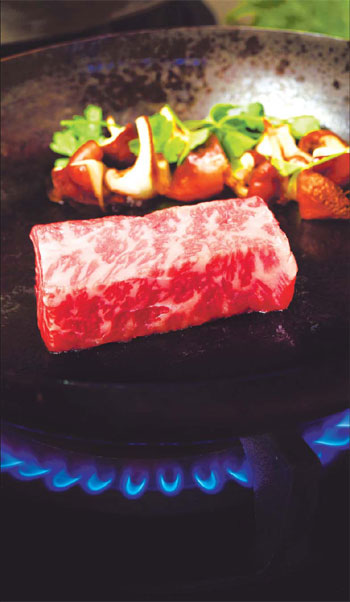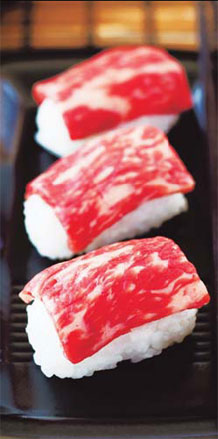A meat for the connoisseur

Black cattle roam freely on lush green pastures to produce some of the world's finest beef. Stuart Beaton looks at Mayura Wagyu from the Limestone Coast.
Mayura Station, on South Australia's Limestone Coast, is home to the largest purebred Wagyu beef cattle herd outside of Japan. Originally bred for heavy work in the fields, Wagyu has now become synonymous with high quality, great-tasting beef. What makes Wagyu beef unique is the marbling of the fat through the muscle. In Wagyu, this very fine vein of fat is distributed throughout the meat, a legacy of times when the original working cattle needed it to draw on as a source of energy to get them through a day of pulling a plow. When cooked, this fat begins to render and dissipate through the flesh, making the meat juicy and tender - almost melting in the mouth.
Mayura cattle are grain fed for a minimum of 500 days - just over 16 months - to enhance this tenderness and give a much more mature flavor to the beef. This tenderness makes it ideal for not only grilling but also for use in hot pots, sushi and even slow cooked char siu Wagyu ribs.
The terroir of the Limestone Coast plays a large part in this. As Scott De Bruin, owner and founder of Mayura Station, says, "the climate here is fantastic. It's not extremely hot or cold, and we have beautiful, very, very old limestone rises and knolls - so we have lots of calcium in the soils for the cattle to grow".
This temperate climate and the fresh coastal air, combined with water that has been purified through the natural limestone aquifer, give rise to lush green pastures on which the young cattle graze. "Livestock that get to roam on these beautiful areas are very lucky indeed," Scott says. "It's like staying at the Ritz for cows."
Chef Kirby Shearing says, "Wagyu beef is so concentrated in unsaturated fats, which reduces the cooking time and makes it so versatile."
|
The marbling of the fat through the muscle makes Wagyu beef unique. Photos by Stuart Beaton / For China Daily |
Shearing has established a Tasting Room at Mayura, akin to a cellar door at a winery. Here visitors can experience a full range of cuts of Wagyu, cooked in different ways, right in front of them. He believes that the use of fresh, local produce further enhances the great flavors already found in the Wagyu.
"Being so close to the coast, I try to use the native products of the area and incorporate them into seasonal menus. So there are things like pigface (a type of Australian native succulent), muntries (a native berry) or coastal wattle - a diverse range of foods that match well to the Wagyu."
Entering Shearing's kitchen at the Mayura Tasting Room is like walking on to the set of TV's Masterchef, and it's here he creates recipes designed to work perfectly with the unique nature of the beef.
As visitors sit on one side of the work area, Shearing artfully prepares tasting dishes in front of them, suffusing the room with wonderful aromas - and the odd flash of flame from the grill.
Although Wagyu beef is high in fat, people shouldn't be concerned over this. Most of the fat is lost in the cooking process, and Mayura Wagyu is also high in beneficial Omega 3 and 6 fatty acids.
Mayura Wagyu beef is widely exported, and can already be found in China, Singapore and Indonesia - as well as some of Australia's finest restaurant menus.
Recipe | Oxtail spring rolls with ginger jelly and soy sauce
Ingredients (10 servings at two rolls each):
250 g spring roll pastry
For the oxtail braise:
1 kg oxtail
1 medium brown onion
1 carrot
1 tsp star anise
1 tsp black peppercorns
200 ml Wagyu stock (or a good beef stock)
200 ml Shiraz
200 ml light soy sauce
80 ml Chinese cooking wine
For the filling:
100 g carrot
80 g onion
50 g glass noodles
10 g ginger
1 clove of garlic
40 ml soy sauce
1 chili
1 tsp fresh coriander
2 tsp Thai basil
2 tsp Vietnamese mint
For the ginger jelly:
135 g ginger
800 ml water
1 gelatine leaf
Garnish:
Soy sauce
80 g glass noodles
coriander
Thai basil
Vietnamese mint
Method:
Cut the tail into segments, heat a large pan or wok and saut the tail until evenly browned, then place into a large Bain Marie.
Cut the onion and carrot into 1-cm cubes, and saut in a pan. Add the peppercorns and star anise and continue to cook for another two minutes, then deglaze with the cooking wine and shiraz and add to tail.
Heat the stock to around 80 C and add to mix with soy sauce. Cook at 90-100 C for around five to six hours - checking halfway if the oven is temperamental. Once cooked, the meat should literally fall off the bone. Place the mix in the fridge and chill. Once cooled, pick off all meat and discard the bones.
For the mix:
Slice all vegetable ingredients into a fine julienne, and place it in a bowl. Place the glass noodles in a bowl and cover with boiling water for seven minutes (or follow the packet instructions), drain and chop roughly and add to the vegetable mix, with the soy sauce, and season to taste. Add the cooled oxtail meat and mix well.
For the jelly:
Soak gelatine in cold water. Finely slice the ginger in a small saucepan, add cold water and bring to a simmer. Remove from heat and allow to steep for around 10 minutes, then strain.
Remove gelatine from water and squeeze out excess water. Add to warm mix and stir until all gelatine has dissolved. Place onto a tray (around 10-cm by 10-cm) and cool in the fridge overnight. Once set, remove from tray and cut into small squares.
For the garnish:
Gently chop or tear the herbs, and mix them in a bowl. In another bowl, soak the noodles in boiling water for around seven minutes, and then separate them into 10 portions.
With a turning fork, twist the noodles, and place on a serving plate to form a nest. Place some soy sauce in little ramekins for dipping.
To roll the spring rolls:
Place the wrapper on the bench so it looks like a square diamond, then place a little of each mix on every roll, making sure they are even and spread out. Pick up the corner closest to the end of the bench and roll over the mix tightly, brush with water and then roll the pastry up, folding over the edges to make a tightly sealed parcel.
To ensemble:
Place spring rolls in a 180 C deep fryer for three to four minutes, then allow to drain.
Cut the rolls in half on an angle, and then place them on the plate with the noodle nest. Scatter the herbs over and serve with the soy sauce.
(China Daily 03/12/2011 page12)















